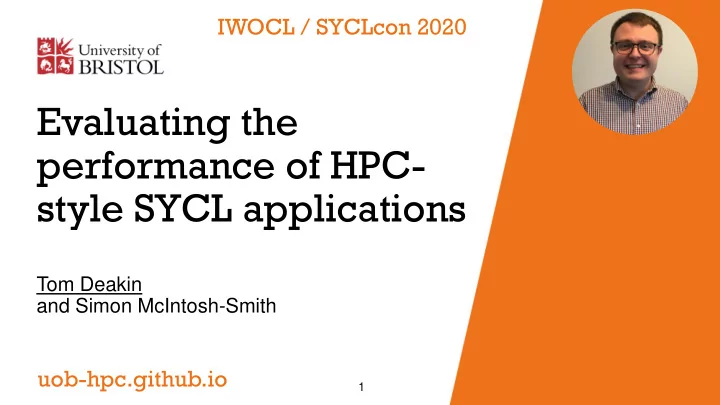

IWOCL / SYCLcon 2020 Evaluating the performance of HPC- style SYCL applications Tom Deakin and Simon McIntosh-Smith uob-hpc.github.io 1
Introduction ▪ SYCL was first released in 2014. ▪ Recent development of different implementations providing support for devices used in the HPC space. ▪ Platforms: ▪ Try out three different compilers: – Intel Xeon Skylake and Iris Pro – Codeplay’s ComputeCpp GPUs – Intel’s oneAPI DPC++ – NVIDIA RTX 2080 Ti GPU – Heidelberg University’s hipSYCL – AMD Radeon VII GPU IWOCL / SYCLcon 2020 2
Platforms IWOCL / SYCLcon 2020 3
Applications ▪ Three applications: – BabelStream ➢ Copy kernel: c[i] = a[i]; ➢ Triad kernel: a[i] = b[i] + scalar * c[i]; ➢ Dot kernel: sum += a[i] * b[i]; – Heat ➢ Simple explicit finite difference solve. ➢ 5-point stencil. – CloverLeaf ➢ 2D structured grid Lagrangian-Eulerian hydrodynamics code. ▪ All are main memory bandwidth bound, like many other HPC applications today. IWOCL / SYCLcon 2020 4
BabelStream: Triad ▪ Results are shown as percentage of theoretical peak bandwidth, so higher is better. ▪ SYCL shows little overhead over direct implementations in the underlying models, particularly on the GPUs. ▪ Intel OpenCL runtime still showing known performance gap with OpenMP on Xeon platforms. IWOCL / SYCLcon 2020 5
BabelStream: Dot ▪ For SYCL, OpenCL, CUDA and HIP, we implemented a global reduction by hand as they don’t have one built in. ▪ Do see some performance loss in the SYCL version compared to what is possible on the platforms. ▪ SYCL performance matches underlying implementations in most cases. IWOCL / SYCLcon 2020 6
BabelStream: Copy ▪ Memory copy kernel, with no floating point operations. ▪ Heat application should behave similarly to this kernel. ▪ See good and consistent performance on all the GPUs. ▪ Observe large range of performance on the Xeon CPU. IWOCL / SYCLcon 2020 7
Heat: average performance ▪ Two SYCL versions: – 2D range: parallel_for <…>(range<2>{ n,n },…) acc[j][i] – 1D range: parallel_for <…>(range<1>{n*n},…) acc[j+i*n] ▪ Consistent performance on NUC and AMD. ▪ Xeon performance mirrors that of BabelStream Copy. ▪ NVIDIA platform shows issues with underlying models, possibly driver related. IWOCL / SYCLcon 2020 8
Heat: comparison to Copy ▪ Compare to performance of Copy as measured for each model. ▪ On Xeon see about 60% of attainable Copy bandwidth. ▪ Consistent performance on NUC. ▪ AMD shows high variability. ▪ This chart highlights the performance issues with CUDA and OpenCL on NVIDIA. IWOCL / SYCLcon 2020 9
CloverLeaf ▪ Chart shows runtime, lower is better. ▪ SYCL within 10% of OpenCL performance. ▪ Reduction cause of performance gap on NVIDIA. ▪ The OpenCL runtime needs improvement on Xeon in order to SYCL to achieve it’s potential as a parallel programming model of choice. IWOCL / SYCLcon 2020 10
uob-hpc.github.io Summary ▪ Often possible to write SYCL applications that get good performance across a number of platforms. ▪ SYCL performance close to lower level model such as OpenCL. ▪ All the source code is available online, at our GitHub page. ▪ Widespread and robust support from all vendors is needed now to ensure SYCL is a success for the HPC community. IWOCL / SYCLcon 2020 11
Recommend
More recommend